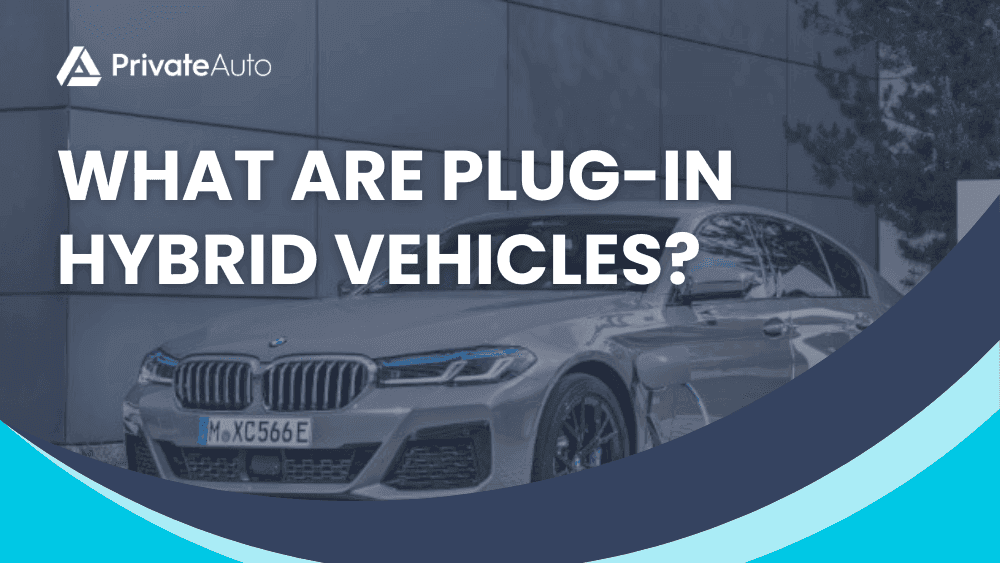What are Plug-In Hybrid Vehicles?
Plug-in hybrids, also known as PHEVs (plug-in hybrid electric vehicles), offer the best of both worlds: electric vehicle efficiency and gas-powered convenience.
These vehicles feature two motors, an electric motor powered by a rechargeable battery and an internal combustion engine (ICE) that runs on gasoline or diesel. Unlike traditional hybrids, PHEVs have larger batteries and can be charged using AC power, much like fully electric vehicles. This allows you to drive on pure electricity for shorter trips, switching to gas for longer journeys.
These vehicles feature two motors, an electric motor powered by a rechargeable battery and an internal combustion engine (ICE) that runs on gasoline or diesel. Unlike traditional hybrids, PHEVs have larger batteries and can be charged using AC power, much like fully electric vehicles. This allows you to drive on pure electricity for shorter trips, switching to gas for longer journeys.
If you're buying a car and want to reduce emissions without sacrificing flexibility, a plug-in hybrid might be the answer. Let's explore how they work and their benefits.
How Do Plug-In Hybrids Work?
You start your journey on battery power, and silently cruise for 20 to 60 miles depending on the model. When the battery runs low, the gas engine kicks in automatically, so you keep rolling.
There are two ways you can charge a plug-in:
1. Plug it into a regular 120-volt outlet for a slow, overnight charge.
2. Use a faster 240-volt Level 2 charger at home or public stations for a full charge in 2-4 hours.
PHEVs also use regenerative braking to recharge while driving, and can blend power from both sources when needed. Even with a drained battery, you're still driving a fuel-efficient hybrid.
There are two ways you can charge a plug-in:
1. Plug it into a regular 120-volt outlet for a slow, overnight charge.
2. Use a faster 240-volt Level 2 charger at home or public stations for a full charge in 2-4 hours.
PHEVs also use regenerative braking to recharge while driving, and can blend power from both sources when needed. Even with a drained battery, you're still driving a fuel-efficient hybrid.
Are There Different Types of Plug-In Hybrids?
Plug-in hybrid electric vehicles come in two main configurations:
1. Series plug-in hybrids
2. Parallel plug-in hybrids
1. Series plug-in hybrids
2. Parallel plug-in hybrids
Series Hybrids
Series plug-in hybrids, also called extended range electric vehicles (EREVs), use the electric motor to drive the wheels, with the gas engine acting as a generator when the battery runs low.
Series hybrids, such as the original Chevy Volt or BMW i3, offer simpler design and efficient electric driving.
Series hybrids, such as the original Chevy Volt or BMW i3, offer simpler design and efficient electric driving.
Parallel Hybrids
Parallel hybrids connect both the electric motor and gas engine to the wheels, allowing for more flexible power delivery. Examples include the Toyota Prius Prime, Toyota Tundra Hybrid and the Ford F-150 Hybrid.
Series hybrids typically have longer all-electric range but might be less efficient on highways, while parallel hybrids often provide better overall fuel economy in mixed driving.
Series hybrids typically have longer all-electric range but might be less efficient on highways, while parallel hybrids often provide better overall fuel economy in mixed driving.
Blended Hybrids
Blended plug-in hybrids use both electric and gas power simultaneously for better efficiency. Unlike traditional PHEVs, they don't wait for the battery to deplete.
This helps in high-demand situations like acceleration. Examples include the Honda Clarity Hybrid and second-gen Chevrolet Volt models.
Benefits are smoother transitions and better fuel economy, but they are more complex and more expensive.
This helps in high-demand situations like acceleration. Examples include the Honda Clarity Hybrid and second-gen Chevrolet Volt models.
Benefits are smoother transitions and better fuel economy, but they are more complex and more expensive.
What are the Advantages of a Plug-In Hybrid?
Here are the advantages of owning a plug-in hybrid electric vehicles compared to conventional vehicles and regular hybrids:
1. Electric-only driving range: PHEVs typically drive 20-60 miles on electric power alone. This allows many drivers to complete their daily commutes without using any gasoline.
2. Reduced fuel consumption: PHEVs use roughly 30% to 60% less petroleum than conventional vehicles. This leads to significant fuel cost savings, especially for short trips and regular commutes.
3. Lower emissions: when operating in electric mode, PHEVs produce zero tailpipe emissions.
4. Flexibility: PHEVs combine the benefits of electric driving for shorter trips with the long-range capability of a gasoline engine, eliminating the range anxiety associated with fully electric vehicles.
5. Cost savings: while PHEVs have higher upfront costs, they can be cheaper to run, especially if most driving is done on electric power. Some models are even eligible for federal tax incentives.
6. Enhanced performance: some PHEVs offer improved performance when both the electric motor and gas engine work together, providing more power than either source alone.
1. Electric-only driving range: PHEVs typically drive 20-60 miles on electric power alone. This allows many drivers to complete their daily commutes without using any gasoline.
2. Reduced fuel consumption: PHEVs use roughly 30% to 60% less petroleum than conventional vehicles. This leads to significant fuel cost savings, especially for short trips and regular commutes.
3. Lower emissions: when operating in electric mode, PHEVs produce zero tailpipe emissions.
4. Flexibility: PHEVs combine the benefits of electric driving for shorter trips with the long-range capability of a gasoline engine, eliminating the range anxiety associated with fully electric vehicles.
5. Cost savings: while PHEVs have higher upfront costs, they can be cheaper to run, especially if most driving is done on electric power. Some models are even eligible for federal tax incentives.
6. Enhanced performance: some PHEVs offer improved performance when both the electric motor and gas engine work together, providing more power than either source alone.
What are the Downsides of a Plug-In Hybrid?
Just like they have their advantages, plug-ins have their not-so-good tradeoffs.
1. Higher upfront cost: PHEVs are more expensive to buy than regular gasoline or diesel vehicles, and often costlier than regular hybrids.
2. Complexity and maintenance: the dual powertrain system in PHEVs is more complex, leading to higher maintenance costs and more complicated repairs.
3. Reduced fuel economy on long trips: once the battery is depleted, PHEVs may have poor fuel economy during extended highway driving, compared to conventional vehicles.
4. Battery life concerns: there are potential issues with battery degradation over time, which could affect the vehicle's performance and resale value.
5. Environmental impact of battery production: the manufacturing process for PHEV batteries involves significant energy use and resource extraction, which can offset some of their environmental benefits.
6. Limited electric-only range: while PHEVs offer an electric-only driving mode, the range is typically much shorter than that of full electric vehicles, usually between 20-60 miles.
7. Charging time: recharging a PHEV can take several hours, especially when using a standard 120-volt household outlet.
8. Weight: the addition of both an electric motor and a gasoline engine, along with a larger battery, makes PHEVs heavier than conventional vehicles.
9. Potential for underutilization: if not regularly charged or primarily used for longer trips, PHEVs may not provide their full benefits.
10. Declining relevance: as full electric vehicles improve in range and charging infrastructure expands, some argue that PHEVs are losing their place as a transitional technology.
1. Higher upfront cost: PHEVs are more expensive to buy than regular gasoline or diesel vehicles, and often costlier than regular hybrids.
2. Complexity and maintenance: the dual powertrain system in PHEVs is more complex, leading to higher maintenance costs and more complicated repairs.
3. Reduced fuel economy on long trips: once the battery is depleted, PHEVs may have poor fuel economy during extended highway driving, compared to conventional vehicles.
4. Battery life concerns: there are potential issues with battery degradation over time, which could affect the vehicle's performance and resale value.
5. Environmental impact of battery production: the manufacturing process for PHEV batteries involves significant energy use and resource extraction, which can offset some of their environmental benefits.
6. Limited electric-only range: while PHEVs offer an electric-only driving mode, the range is typically much shorter than that of full electric vehicles, usually between 20-60 miles.
7. Charging time: recharging a PHEV can take several hours, especially when using a standard 120-volt household outlet.
8. Weight: the addition of both an electric motor and a gasoline engine, along with a larger battery, makes PHEVs heavier than conventional vehicles.
9. Potential for underutilization: if not regularly charged or primarily used for longer trips, PHEVs may not provide their full benefits.
10. Declining relevance: as full electric vehicles improve in range and charging infrastructure expands, some argue that PHEVs are losing their place as a transitional technology.
Can I Get Federal Tax Credit For a Plug-In Hybrid?
You can get a federal tax credit for a PHEV. The amount of the credit depends on the battery capacity and can range from $2,500 to $7,500. To qualify, the car must meet specific requirements set by the IRS, and the manufacturer must not have exceeded the limit of 200,000 eligible vehicles sold.
Most Popular Plug-in Hybrids
Here are some of the most popular plug-in hybrids, known for their efficiency, practicality, and advanced features:
1. Toyota Prius Prime
2. Toyota RAV4 Prime
3. Hyundai Tucson
4. Mitsubishi Outlander
5. Kia Sportage
6. Chrysler Pacifica
7. BMW X5 xDrive50e
8. Ford Escape
9. BMW 3 Series Hybrid
10. Volvo S90 Recharge
11. Volvo S60 Recharge
12. Mercedes-Benz S 580e Hybrid
1. Toyota Prius Prime
2. Toyota RAV4 Prime
3. Hyundai Tucson
4. Mitsubishi Outlander
5. Kia Sportage
6. Chrysler Pacifica
7. BMW X5 xDrive50e
8. Ford Escape
9. BMW 3 Series Hybrid
10. Volvo S90 Recharge
11. Volvo S60 Recharge
12. Mercedes-Benz S 580e Hybrid
Plug-In Hybrids FAQ
What is the point of a plug-in hybrid car?
The point of a plug-in hybrid is to offer a "best of both worlds" solution, combining three advantages:
1. Flexibility: you get the benefits of electric driving for daily commutes and short trips, plus the long-range capability of a gas engine for longer journeys. This eliminates the range anxiety associated with full electric vehicles.
2. Cost and environmental benefits: PHEVs can significantly reduce fuel consumption and emissions, especially for short trips. They offer the potential for zero-emission driving on daily commutes.
3. Transitional technology: PHEVs provide an easy transition to electric driving. They allow drivers to get used to charging routines and electric vehicle operation without fully committing to an all-electric vehicle.
1. Flexibility: you get the benefits of electric driving for daily commutes and short trips, plus the long-range capability of a gas engine for longer journeys. This eliminates the range anxiety associated with full electric vehicles.
2. Cost and environmental benefits: PHEVs can significantly reduce fuel consumption and emissions, especially for short trips. They offer the potential for zero-emission driving on daily commutes.
3. Transitional technology: PHEVs provide an easy transition to electric driving. They allow drivers to get used to charging routines and electric vehicle operation without fully committing to an all-electric vehicle.


